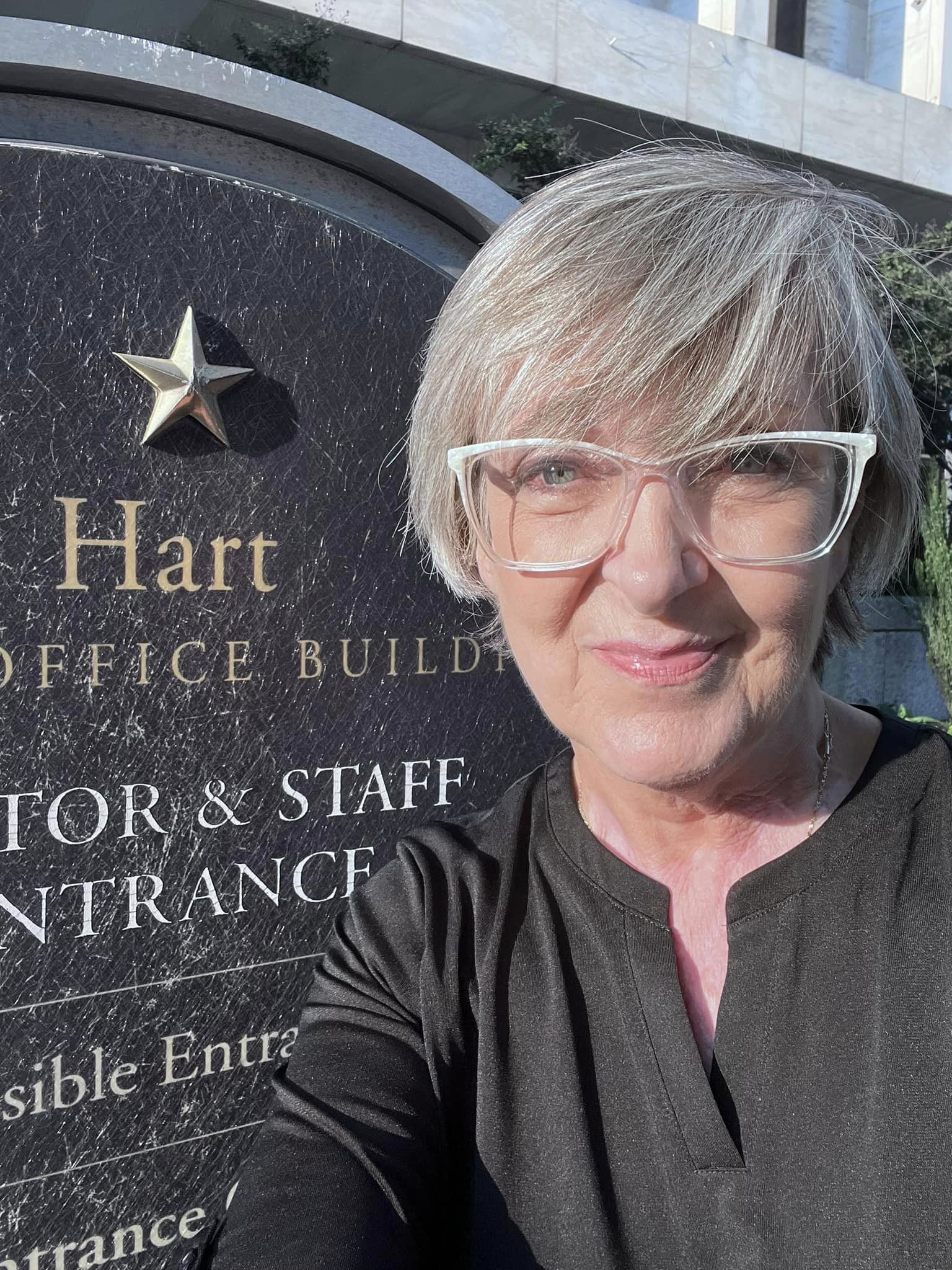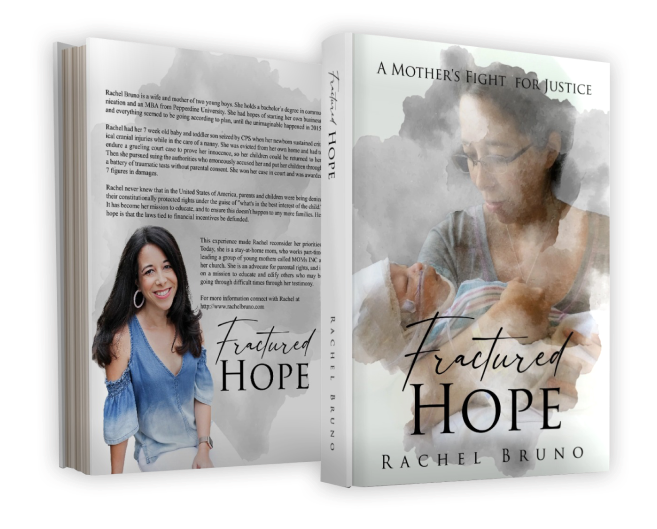by Sally Hendrick, Editor in Chief, with Connie Reguli and Rachel Bruno, Contributors
I thought I was going to DC to dig out some sort of corruption that lingers in the shadows, but the feeling I left with was not that at all. I left with the confidence that if people organize and bring their ills to the table via grassroots efforts, they will be heard. It takes dedication to your cause, to keep up the pressure, to gather supporters, and to understand how legislation works.
Child welfare advocates are doing the hard work.
Gathered around a glass-top table in varying forms of dress, a dozen women advocating for families are chatting and furiously typing away to organize meetings with legislators before marching to the offices of the U.S. Senate and House on Capitol Hill in the coming days.
“I’ve got Tennessee!”
“Connecticut on the books!”
“Sweet home, Alabama!”
Meanwhile the chatter of stories that brought most of these women together in the first place is buzzing around the room.
“My court-appointed attorney wouldn’t file my documentation, and they had my children for 10 months! I finally secured an advocate who helped me compile my notes, and when a last-minute hearing popped up on the calendar. I filed the evidence myself, and my three children were returned to me within 24 hours. Case dismissed,” explained Heather C. of Arizona.
Her voice was full of anxiety and relief at the same time. Heather was a parent who reached out for help and instead, her three little girls were removed three times in a period of 2 years.
@my.three.plus.me Backtrack to the roots... #lawyersoftiktok #WomenOwnedBusiness #governmentcorruption #CPS #PTSD #america #justice ♬ original sound - Heather
I am not believing what I’m hearing from these mothers who are experiencing PTSD (post traumatic stress disorder) and a trauma-induced anxiety that comes from the gut wrenching experience of separating a child from his mother. After months and years of fighting the system many of these parents face the ultimate death sentence of family relationships called termination of parental rights. I am beginning to see that this system that exists to serve, seeks to exist, and families are stuck in this purgatory for years. One woman still hasn’t been reunited with her seven children after four years of hell.
Last month I had no idea that I would be in Washington D.C. learning the ins and outs of how Child Protective Services works across this country. The fallout from conflicting legislation and funding mechanisms is real, and it isn’t working as intended.
Let me put it this way, when funding rewards a result, the bureaucracy will work towards achieving that result whether it benefits the public or not. The child welfare federal taxpayers funding is set up so that taking children away from parents earns the state money. Keeping families together earns them nothing. Whatever the problem that sparked an investigation in the first place morphs into a diabolical paradigm of family destruction and any intentions to keep families together fall by the wayside. The focus should be on healing and unifying relationships, but the money-grab for Title IV-E funding gets first dibs.
In reported cases of child abuse or neglect, why fight so hard to put these children back with their families?
Studies show that 4 out of 5 investigations eventually prove to be false. That’s 80% of the cases that have no doubt caused some family disruption due to government intrusion. When a child is removed from the home as case workers initiate an inquiry and damage is immediately done to these families by way of reputation, financial stability, emotional well-being, mental stress, trauma, and oftentimes permanent ruin to people’s lives. Everyday thousands of American families face this challenge to their pursuit of life, liberty, happiness, and basic human rights.
Not all cases are alike.
A child welfare investigation commences with a “referral” which can be initiated by a phone call or email to the government agency. Every state allows reports to come from “anonymous” tips which, by itself, invites a plethora of problems. False reports from angry neighbors, or upset teachers can cast a family into a baseless investigation.
Legitimate concerns for the safety of children ensues when one of the following events occurs or is suspected to have occurred:
- Child Abuse
- Child Neglect
- Partner Domestic Violence
- Substance Abuse and Drug Exposure
- Violating court orders which were meant to protect children

Photo: Connie Reguli in front of the congressional offices.
Family advocates, such as Connie Reguli of the Family Forward Foundation, categorize the harm being done by Child Protective Services as one of the following:
- Faulty investigations
- Faulty record-keeping
- Refusal for placement with a relative
- False reporting
- Medical kidnapping
- Lack of rehabilitation
When families are given the resources to resolve their problems, rather than punishing them for not having enough money for the help they need, outcomes for those children turn out much better.
The statistics around child welfare are astounding.
On average, there are nearly 450,000 children in the US foster care system at any given time, according to the Children’s Law Center of California. These foster agencies are private for-profit organizations who want to keep children in the care of strangers, instead of restoring the family of origin.
Once a foster child turns 18, they are aged out of the system and the families that took care of them are no longer eligible for funding. If the foster family adopts the child, they’re eligible for funding until their 22nd birthday. These “aged-out” foster children are legal orphans with no family support as they enter adulthood. The government seeks to make-up for this alienation by giving them a stipend for the next four years, but only if they attend college. This “welfare assistance” for young adults does not cure the lifelong impact of loss of trust and support at an emotional level.
The National Foster Youth Institute (NFYI) states the following statistics:
- Of the kids who age out of the system at 18, 20% become homeless.
- Those that go on to graduate from college make up less than 3%.
- Seventy percent (70%) of girls become pregnant by age 21.
- PTSD (post traumatic stress disorder) is a burden that 25% of former fosters carry
It is no wonder that 60% of child sex trafficking victims have been wards of the state at some point in their lives, per SOS Children’s Villages of Illinois. Many of these “aged-out” foster kids are revictimized if they do start a family by having their own children removed. The system is a massive social experiment that has failed our children. The school to prison pipeline is filled with kids who have been in 5 or more foster home placements within the child welfare system. The figures show that upwards of 90% of these kids are affected, according to the Juvenile Law Center.
Where does the money come from, and where does it go?
Title IV-E funding is the purse for foster care and adoption, and there are multiple ways to access that money. This particular piece of the pie comes from the Social Security Act. Title IV-E is an “entitlement” and not an “appropriation”. That means it never has to be approved in Congress’s budget; it is never subject to sequester; and it is a “use it or lose it” financial scheme. The trickle down effect is an incentive to every state to keep a quota of kids in the system.
Additional legislation comes from AFSA, the Adoption and Safe Families Act of 1997. Incentives for this program are doing more harm than good, according to the Parental Rights Foundation. Up to $20,000 in funding is handed out when a child is adopted into a new family. The money isn't necessarily used to rehabilitate the family but to give bonuses to agencies for separating the child legally more often than not and to continue giving the adoptive family a monthly stipend after adoption.
In most criminal and civil matters, there is a thing called ‘due process’, which ensures the rights of individuals on matters such as being given notice of an investigation, being appointed an attorney or advocate to inform them of what is happening without a conflict of interest with the state, and many other rights that citizens enjoy under the 14th amendment to the US Constitution. When it comes to matters of child welfare, due process is left out of the equation in most situations.
That’s where the Family Forward Foundation comes into play.
Funding is an issue. These women, including myself, went to DC at our own expense to lobby for children. It was a mish-mash of moms and professionals spending our vacation time in Congress members’ offices asking to be heard. It works best when you have a constituent from their state in the room, as politicians’ priorities go something like this:
- To keep their jobs and raise money,
- To show their states they’re working for them, and
- To cater to the party they’re loyal to…
…in that order.
Personal politics aside, it’s important to keep your emotions in check around political issues, tug at their hearts through real stories, speak to the issues they represent, and know the pieces of legislation that need to be addressed.
Save the conversations around money to come after the initial meetings because this group of activists know that the huge foster care corporations are lobbying and paying the legislators to keep things the same. But these women side step that topic and focus on new laws that will help strengthen families in this process. In that process, they find someone who can write bill text, as it will go through intensive legislative review.
Know how funding works
The Family First Prevention and Services Act passed in 2018, because of the diligent work of these women, whom I learn have been pounding the concrete in D.C. since 2015. This new legislation redirects Title IV-E funding for foster care to in-home family services for 12 months prior to removal.
This funding would allow families who are tagged in the system as struggling with substance abuse issues, or housing challenges, or medical emergencies, time and services to restabilize their families.
As of October 2022, many states have not yet implemented the legislation requesting extension after extension. This is part of the reason we went to D.C. to draw attention to the details around funding.
The motivation for funding should be to keep the family together, rather than split them apart, when we know that 80% of cases are ultimately unfounded.
The Family Forward Foundation is asking for the states that have dragged their feet to implement the Family First Prevention Services Act to give these families a chance to respond before Child Protective Services violates their due process rights.
The Parent Advocate Bill, written by Connie Reguli, is part of the reform. This bill ensures that every family investigated has the right to an independent advocate upon first contact with Child Protective Services (CPS).
Reguli, a family attorney who has worked in the trenches with families for 28 years, explains, “This system is adversarial from day one. When a CPS worker knocks on a parent’s door, panic sets in. For good reason, children are removed on the flimsiest of reasons based on “concerns” or “predicted harm”.
These children are taken to the home of a stranger and dropped off with an armful of their clothes if they are lucky. Imagine for yourself, if a police officer picked you up and drove you 200 miles away and dropped you on someone’s doorstep.”
Reguli went on to explain that parents need to understand their rights from day-one of involvement with the government. “Today, we have advocates in healthcare, education, disability, and elder care. The time is ripe for parents to have this type of support.”
A family advocate is well versed on the law and policies that control that agency. The agencies often play a cat-and-mouse game with parents, such as telling them they have to take an anger management class and then failing to provide them resources or rejecting the parents' choices.
They force the parents through a series of classes and evaluations even BEFORE there has been any court process that finds them guilty of anything. “It’s insane,” Reguli says.
The way it is now, CPS gets a report or anonymous tip, shows up to your door or your hospital room, and asks to speak with you under the guise that they are there to help you. They’re not obligated by law to say you’re under investigation, nor do they have to inform you of your rights. They are gathering information from you as if you’re guilty of some criminal act against your child or children.
Lessons from Capitol Hill
On the Shout Your Cause TikTok account, Sally talks about making headway in Washington by using the language of who you're talking to in order to get and keep their attention.
@shoutyourcause Turn your advocacy into action with stories, facts, and language that aligns with the mission of your audience. #capitolhill #congress #advocacy #activism ♬ original sound - Sally with a Why
Guilty until proven innocent
Another case that was presented to legislators on our trip to D.C. is that of Rachel Bruno. Rachel's case recently settled for a seven-figure settlement in damages to her family by the government and various agencies.
In Rachel’s case, both of her babies were removed from her home by CPS because her infant was critically injured while in the care of his nanny. She woke up to her son screaming at 4 am, and the nanny said she had just fed him, that he was really gassy. He was 7 weeks old, so she didn’t suspect anything was truly wrong with him. However, after 6 hours of non-stop crying, not nursing, not napping, she called the pediatrician. That route wasn’t going to be fast enough, so she took him to the emergency room.
The nurses in the ER asked what happened, vitals appeared normal, but the doctor came in, observed her child, and knew there was fluid leaking from her child’s brain. This ended up being due to a cranial fracture and an intracerebral blood hemorrhage, which was confirmed 15 minutes after a CT scan was performed. They had to do emergency surgery to save her child.
Rachel was in shock. There was nothing that she had done to cause this. However, due to the need of the hospital to report this type of injury, her family was under investigation before she even knew what was happening. Ultimately, Rachel was cleared of a criminal investigation, but the damage done was that both her babies were taken away from her. Within 12 hours of arriving at the hospital, both were considered wards of the state of California.
The investigation continued to try to pin this on Rachel without properly investigating the nanny. Within 72 hours, they had an emergency hearing, and the kids were fortunately placed with her husband since he was not home at the time. She was told she wouldn’t get her kids back and that she faced up to 15 years in jail if they decided to charge her. Her lawyer told her that in family court, there is no constitutional law or due process. Under a child welfare investigation, they will do whatever they deem is in the best interest of the child.
After the 72 hour hearing, Rachel had to leave her home, take child abuse classes, parenting classes, and individual counseling. She was given 7 hours of monitored visitation with both of her children each week.
After 40 days and 40 nights, Rachel had a hearing where her attorney had a ‘no contest plea’ for her. He had 700 pages of documents for her to sign, not admitting any guilt, then she could go home that day. She signed it because getting to go home was her top priority, and her lawyer had never seen anyone get to go home before trial. The case remained open, criminally and with CPS, but she was still court-ordered to finish the orders. A social worker came to her house once a month for 6 months, unannounced. After that, the social worker recommended the case be closed. Rachel showed up to court, was exonerated, and went home.
What Rachel witnessed throughout this process felt wrong, and she knew she had to speak up about it. Contacting civil rights attorney, Shawn McMillan, was the first step towards a lawsuit against all entities involved in her case, and she won by settling her case for seven figures. To get her full story, Rachel authored the book, Fractured Hope, A Mother’s Fight for Justice.
The fight continues...
Season 4 of the Shout Your Cause with Sally Hendrick is dedicated to stories like Rachel's and what is being done by extraordinary people from all walks of life to help prevent bad outcomes.







